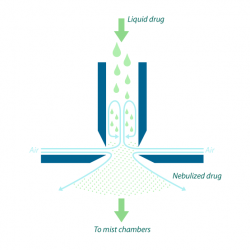A step forward towards therapeutic aerosols
To cure infections located in lungs, you can deliver antibiotic through the blood vessels or directly via the airways. Despite the many advantages of pulmonary delivery, few nebulization systems are designed. The PneumoNP project develops an antibiotic formulation acting against drug resistant pneumonia. As it aimed for inhaled therapy, an aerosol system was chosen to deliver it. The Spanish company Ingeniatrics Technologías S.L. is in charge of prototyping the nebulizer device. Setting up a nebulizer requires more than a random combination of compressed air and liquid. Indeed, the output needs to fulfill many conditions to be efficient. Amongst others, the mist has to be breathable. So, droplets should be smaller than 3 μm to reach each corner of the lung. Achieving this result was especially challenging as the drug formulation contained large molecules. Ingeniatrics used its technology called Flow Blurring® to produce the aerosol prototype. The Flow Blurring® relies on an atomisation technique that creates an ultra-fine mist from liquid; besides, it requires less energy compared to collision nebulizers. The microfluidic system produces turbulent mixing between a compressed air and the liquid drug. It yields droplets that are smaller than the output pipe. The system is versatile including, not only the proper fluid delivery accessories, but also the possibility to use mist chambers in combination with the Flow Blurring® technology. As of today, the prototype is already in function. In the Dutch Erasmus Medical Center and in the Spanish CIC Biomagune laboratories, rats have been accustomed to the prototype setup. Now, researchers can look at the healing time of the rats when they inhale the drug. Initially designed for these in-vivo tests on rodents, the aerosol prototype has also been adapted to in-vitro investigations. In particular, researchers of the German Fraunhofer ITEM expose human epithelial lung cells to the therapeutic mist. They measure cytotoxicity and efficiency indices with this setup. The aerosol delivery prototype will benefit from these users’ feedbacks for further refinement of the system. If the aerosol system is promising enough, it may become an industrial medical device for human or animal use.
Keywords
Nebulizer, Pneumonia, Lung infection, Therapeutics
Countries
Spain



